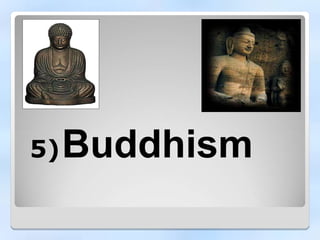
Buddhism's Four Noble Truths
- 1. 5)Buddhism
- 3. Founder Siddhartha Gautama (Gautama Buddha) was the founder of Buddhism and was born in present day Nepal. Siddhartha was born in a royal Hindu family and would have had several roles as a Prince in his community. He eventually moved to India to have a more meaningful role in people’s personal lives.
- 4. • Founder: Siddhartha Gautama • Earliest sources for the life of Buddha date from the 2nd century AD • Siddhartha was born a prince around 563 BC in Ancient India – Grew up surrounded by luxury, married a beautiful woman and had a happy life – At age 29 he took a ride beyond the palace gates and saw a sick man, an old man, a poor man, and a dead body • Disturbed, he left his family to find the “realm of life where there is no suffering nor death
- 5. Gautama becomes Buddha • Siddhartha Gautama wandered for years and meet with Hindu Scholars, whose ideas didn’t answer his questions • He fasted and meditated under a tree pondering the mystery of life • Legend tells that during the night evil spirits tempted Gautama to give up meditating, but he didn’t • After he rose, he believed he understood the cause and cure for suffering and sorrow • He then became Buddha or “Enlightened One”
- 6. Historical Context of founding After forty-nine days of meditation Gautama Buddha was awakened, otherwise known as reaching enlightenment. After reaching enlightenment, under a tree in India, he promised to spread the knowledge he just learned about how to end suffering.
- 7. Major Beliefs: –Life is suffering –Follow the 4 Noble Truths and Eightfold Path –This Path leads to better Karma and a life purity A pure and enlightened soul can ultimately achieve Nirvana
- 8. Key Teachings Buddhism • Four Noble Truths: – 1. All life is full of suffering, pain, and sorrow – 2. The cause of suffering is nonvirtue, thinking such as hatred and desire – 3. The only cure for suffering is to overcome these negative deeds and thoughts – 4. The way to overcome these negative deeds and thoughts is to follow the Eightfold Path
- 9. The Eight-fold Path • The Eight-fold Path Means: • Right views, • right intentions, • right speech, • right conduct, • right livelihood, • right effort, • right mindfulness, • right contemplation
- 10. The Eightfold Path • A person has to live a moral life, avoiding evil • By meditating, you can reach Nirvana • Final Goal: Nirvana, union with the universe and release from the cycle of reincarnation • Buddhism stresses honesty, charity, and kindness to all living creatures: Rejects the Caste System!
- 11. According to Buddhism, after death one is either reborn into another body (reincarnated) or enters nirvana. Only Buddhas (those who have attained enlightenment) will achieve nirvana. The Buddha said of death: Nirvana Nirvana is the state of final liberation from the cycle of death and rebirth. It is also therefore the end of suffering. The literal meaning of the word is "to extinguish," in the way that a fire goes out when it runs out of fuel. What is it like? Is it like heaven, or is it non- existence? The answer is not clear, Buddha only says it is "incomprehensible, indescribable, inconceivable, unutterable."
- 12. Ancient Ways The Buddha taught that following the Vedic texts was unnecessary. Challenged the authority of Hindu priests Changing Society A more individualistic approach to enlightenment Rebirth as a means to evolve Levels above human but below Nirvana Many realms including a Hades like place Challenging Hindu Ideas Caste System Opposed caste system The Eightfold Path could lead any individual to nirvana. The Buddha’s teachings reached all classes.
- 13. The Spread of Buddhism Spheres of Influence Theravada Mahayana Vajrayana Buddhism out of India by 1000 AD http://www.bergen.edu/faculty/gcronk/Buddhism.ppt
- 14. Where has Buddhism disappeared?
- 15. The Major Buddhist Traditions • Theravada: 300BC or earlier (“The Way of the Elders”) - Sri Lanka & Southeast Asia. Only monks can reach Nirvana • Mahayana: 200CE (“The Greater Vehicle”) - China, Korea, & Japan (& Tibet & Mongolia) Believe in angel-like beings, different gods and saints, Nirvana is open to all. • Vajrayana 800CE (“The Way of the Diamond Thunderbolt”) - Tibet & Mongolia, sect containing the position of Lama(Guru) many polytheistic gods All of these allow for the worship of traditional pre-buddhist gods
- 16. Symbols The eight-spoked wheel symbolizes the Buddha’s turning of the Wheel of Truth or Law. There are eight spokes to reference the Noble Eightfold Path of Buddhism, which is the path Buddhists believe can end suffering in their lives. This path involves becoming more wise, righteous, and thoughtful in life.
- 17. Place of worship Buddhists worship and meditate in a temple known as a Vihara. A Vihara is a huge square temple with roofs that slope down and outward from the building.
- 18. Major Beliefs Death leads to rebirth into a new life (Reincarnation) All events in life is a consequence of actions done in the past life (Karma) Cycle of Rebirth is escaped only by achieving Nirvana Nirvana: unborn, unoriginated, uncreated, unformed – achieved by ultimate purity of life Siddha-Shila – where liberated souls reside
- 19. Three Jewels: When a person accepts the Buddhist philosophy and wants to make it part of their life, the traditional way is to say "I take refuge in the Buddha, I take refuge in the Dharma, I take refuge in the Sangha." 2/8/18